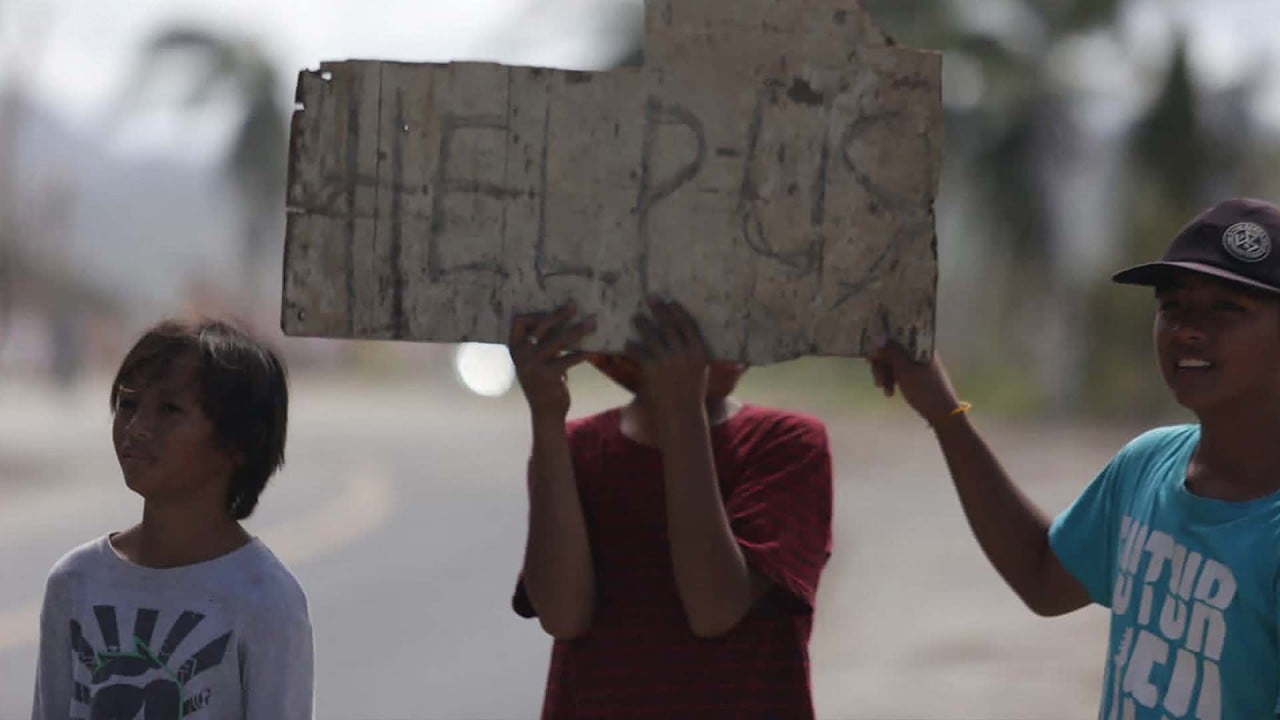
Philippines typhoon Rai: ‘Please don’t forget us’; homes, water, food, power shortages
- Governor of hard-hit Bohol province, where more than 100 people died and 150,000 houses were destroyed or damaged, asks foreign aid agencies to help
- ‘There is overwhelming fear, there are no gifts, there were no Christmas Eve dinners, there is none of that today’, said Governor Arthur Yap
Hundreds of thousands of people in the Philippines, Asia’s largest Roman Catholic nation, were marking Christmas on Saturday without homes, adequate food and water, electricity and mobile phone connections after a powerful typhoon left at least 375 people dead last week and devastated mostly central island provinces.
More than 371,000 houses were either damaged or blown away in the storm. Before Typhoon Rai hit on December 16, millions of people were heading back to shopping centres, public parks and churches after an alarming spike in Covid-19 infections in September eased considerably in recent weeks with more vaccinations and lighter quarantine restrictions keeping Omicron cases in the country to just three so far.
Governor Arthur Yap of hard-hit Bohol province, where more than 100 people died in the typhoon and about 150,000 houses were either blown away or damaged, asked foreign aid agencies on Saturday to help provide temporary shelters and water-filtration systems to supplement Philippine government aid.

“I refuse to believe that there’s no Christmas spirit today among our people. They’re conservative Catholics. But it’s obviously very muted. There is overwhelming fear, there are no gifts, there were no Christmas Eve dinners, there is none of that today,” Yap said by cellphone.
Yap said he was happy that many Filipinos could celebrate Christmas more safely after Covid-19 cases dropped, but he pleaded: “Please don’t forget us.”
In Manila, which was not hit by the typhoon, Filipino Catholics were relieved to be able to return to churches on Christmas on Saturday, although only a fraction were allowed inside and worshippers were required to wear masks and stand at a safe distance from each other.

Meanwhile, Father Ricardo Virtudazo stands in a pool of water in his typhoon-hit church in the southern Philippines delivering Christmas Day mass to dozens of devotees whose wishes this year were for new roofs, food and fine weather.
Survivors clung to family and faith after their homes – and planned festivities – were wiped out.
“What’s important is all of us are safe,” said Joy Parera, 31, attending Christmas mass with her husband at San Isidro Labrador Parish church in the town of Alegria, on the northern tip of Mindanao island.
A light rain soaked the pews and white tiled floor of the damaged church, which has been left with a gaping hole in the roof after Rai ravaged the area. Devotees wore masks as they gathered inside the church festooned with Christmas decorations and prayed for a better year.
“We still have hope,” Virtudazo said. “In spite of the calamities they experience, they still have faith in God.”
Christmas is one of the most important events in the Christian calendar and in the Catholic-majority Philippines, families typically gather to share a meal. But the widespread destruction caused by Rai in the southern and central regions of the country has dampened celebrations as many survivors plead for drinking water and food.
Mindanao, Siargao, Dinagat and Bohol islands are among the most devastated by the storm, which knocked out electricity, tore off roofs, shredded wooden buildings, felled concrete power poles and uprooted trees.
The scale of the damage, lack of mobile phone signal or internet in many areas, and depleted government coffers after the Covid-19 response were hampering efforts to distribute aid.
Nardel Vicente said his Christmas wish was for someone to help him buy a new roof for his house in Alegria after it was wrecked by Rai, which hit the country on December 16 as a super typhoon.
Jobless and with little money to spare, Vicente said his family would not be able to prepare a festive meal this year. “In previous years we had spaghetti, pork, chicken – whatever we could afford between us,” the 38-year-old said.
But he added: “That’s ok, we’re alive. It’s better than welcoming Christmas with a dead loved one.”
Marites Sotis usually serves up meat, spring rolls and salad for her family. “We won’t have those this year because they cost a lot of money,” Sotis, 53, told AFP in the coastal municipality of Placer where the storm felled most of her family’s coconut trees. “We’ll make do with spaghetti.”
Some survivors in nearby Surigao City have been standing on roads for days begging for money and food from passing motorists after failing to receive a scrap of government assistance.
Inaga Edulzura, 41, said she hoped to get a packet of spaghetti to cook for her family. Otherwise, they would “make do with sliced bread. Our only request is that there’s fine weather on Christmas Day to give us some cheer.”
Reporting by AP and AFP.


.png?itok=arIb17P0)

